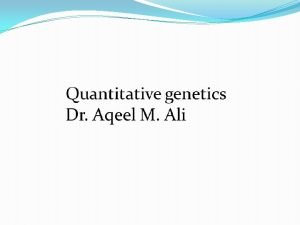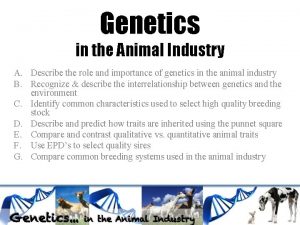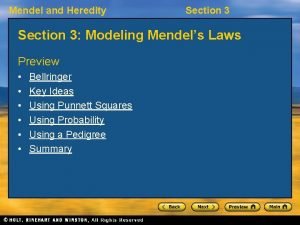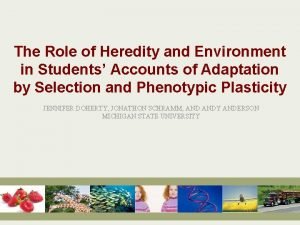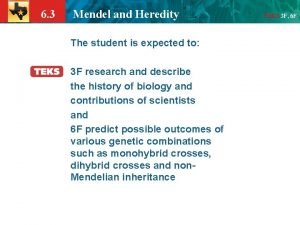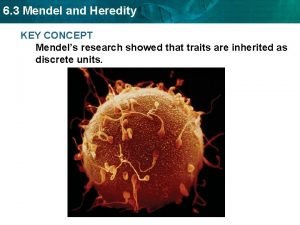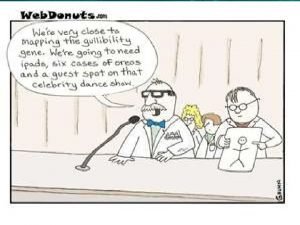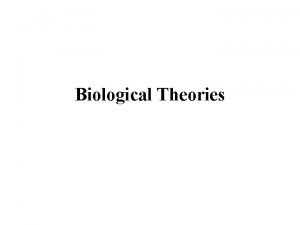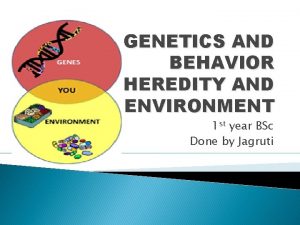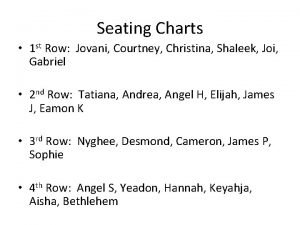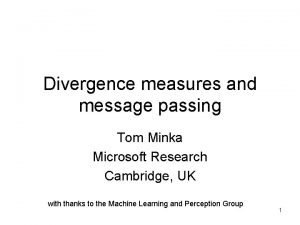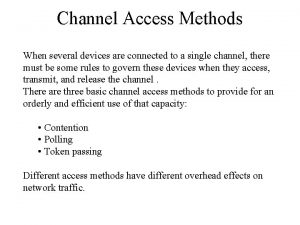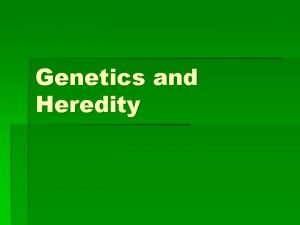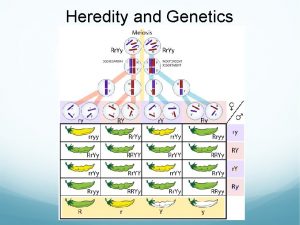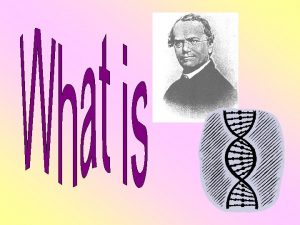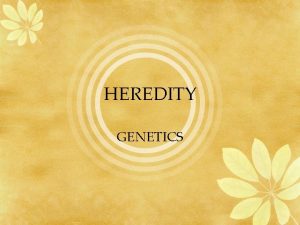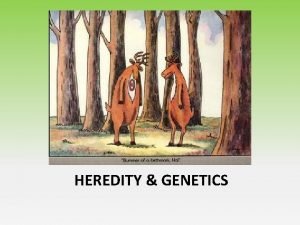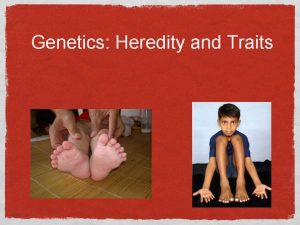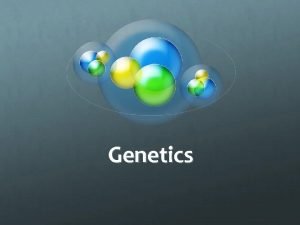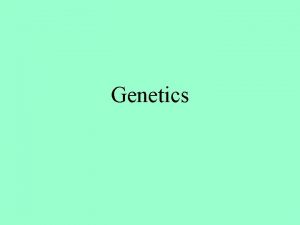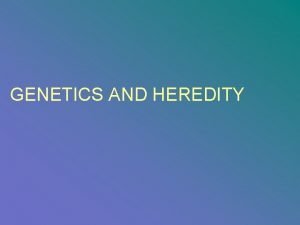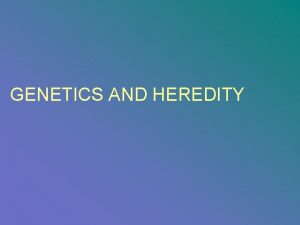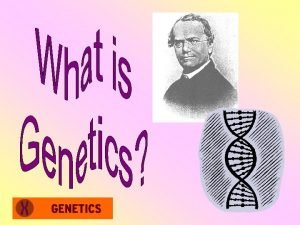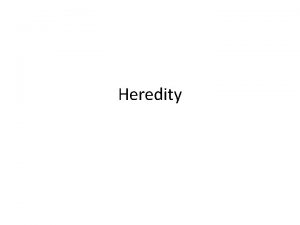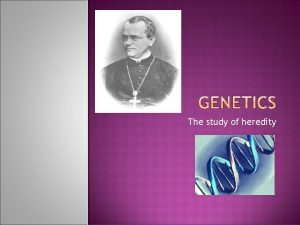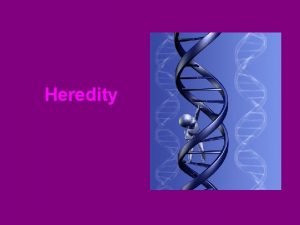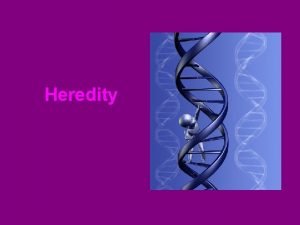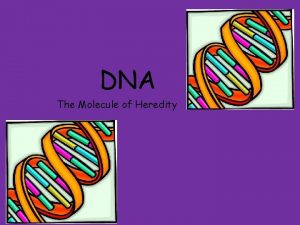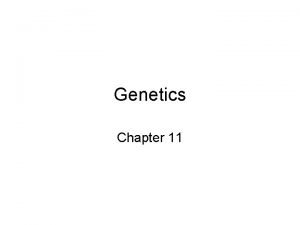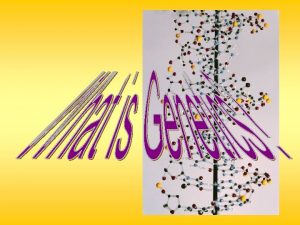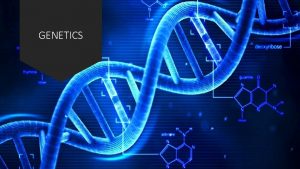Genetics and Heredity HEREDITY The passing of traits












































- Slides: 44

Genetics and Heredity

HEREDITY § The passing of traits from parents to offspring.

TRAIT 2 § A characteristic of an organism § Examples include: height, skin color, eye color, freckles, nose shape, etc. § Traits are controlled by genes. § What traits did Mendel observe in pea plants? (p. 218)

26 GENETICS § Study of the passing on of characteristics from one organism to its offspring § Make sure #26 mentions Gregor Mendel! 1





4 GENE 3 10 • • § The set of information that a controls a trait It is a segment of DNA on a chromosome Genes come in 2 forms (allele-forms of a gene): a. DOMINANT: allele that will always be expressed (shown) in an offspring • Tries to PREVENT the expression of recessive gene What are some examples of alleles? (p. 221) Which alleles on page 221 are DOMINANT?

11 b. RECESSIVE: allele that will only be expressed if there are no dominant alleles present • Is prevented from showing up if there is a dominant allele present Which alleles on page 221 are recessive?

Dominant & Recessive § Example: § Eyecolor- Brown eyes are dominant and blue eyes are recessive. § A person can have a brown allele and a blue allele but still have brown eyes because the brown allele is dominant and hides the blue allele (it’s recessive).

Dominant & Recessive § Dominant alleles are represented with a capital letter. (Add this to Card #10) § Recessive alleles are represented with a lowercase letter. (Add this to Card #11) § R = Dominant § r = recessive § An organism is represented by two letters for each allele (or gene that comes from mom and dad)

Homozygous/Heterozygous (p. 230) 9 8 § Homozygous (purebred)-when a species has two identical (genes)alleles for a trait § Represented by the same 2 letters § Ex. BB (dominant) or bb (recessive) § Heterozygous (hybrid)-when a species has two different (genes) alleles for a trait § Represented by 2 different letters § Ex. Bb

Genotypes vs. Phenotypes (p. 230) 24 § Genotype- genes in an organism that are 25 § § § present Ex. Bb, bb or BB (Add to #24) Phenotype- an organism’s physical traits (or visible traits) Ex. Brown eyes, brown hair (Add to #25)

Law of Dominance 12 § This means if the two alleles are different, one usually wins out. § Think of sports. Dominance in sports means one team usually wins out.

Law of Independent Assortment 13 § § § Independent = by themselves Assortment = how things are sorted out This means if multiple traits get passed along, those alleles get sorted out each by themselves. § For example, getting one allele for one trait doesn’t mean you can only get a certain allele for another trait.

Law of Segregation 14 § Segregation means separating. § When reproductive cells are made, all the pairs of alleles separate. Each gamete contains 1 allele for each trait.

MUTATION § Change in a gene’s information (like a change in instructions)

Mutations can be: § HELPFUL § HARMFUL Examples include: Down’s syndrome, color blindness, albinism, sickle cell anemia § NEUTRAL


15 PUNNET SQUARE § A mathematical model used to predict the chances that offspring will inherit genes from their parents

SAMPLE PUNNET SQUARE

Practice problem #1 § Predict the genotypes for the fur color of the offspring of a brown, heterozygous hamster and a white homozygous hamster. Brown is dominant and white is recessive.


Problem #2 § Predict the gentoypes of the offspring of 2 white homozygous cows. Black is dominant over white.

#2

Problem #3 § Predict the genotypes of the offspring of 2 gray heterozygous rats. Gray is dominant over white, which is recessive.

#3

Practice problem #4 § What are the chances of having a girl or a boy baby? § How would you make a Punnett Square to show it?

#4

Pedigree Charts 7 § Pedigree: a chart of the genetic history of a family over several generations § They are used to find out the probability of a child having a disorder or a certain trait in a family.

Symbols on a Pedigree Female: Male:

Connecting Pedigree Symbols: § Examples of connected symbols: § Married couple § Children §

More symbols in a Ped. Chart:

Example of a ped. Chart: § What does a pedigree chart look like?

Interpreting a Ped. Chart: § 1. Determine if the pedigree chart shows an autosomal or X-linked disease/disorder. § If one sex in the pedigree is affected, it is X-linked. § It is a 50/50 ration between sexes, the disorder/disease is autosomal. Autosomal doesn’t affect just one sex.

Is it autosomal or Xlinked?

§ Autosomal…why? ?

Interpreting Ped. Chart cont. § 2. Determine whether the disorder is dominant or recessive. § If it is dominant, one of the parents must have the disorder/trait/disease. § It is is recessive, neither parent has to have the trait/disorder because they can be heterozygous (Bb).

Dominant or Recessive?

§ Dominant…. why? ?

Dominant or Recessive? ? ?

§ Recessive…. . why? ? ?

§ You are researching the inheritance of a red colored tongue in a lizard…. § Is it autosomal or X-linked? § Is it dominant or recessive?
 Genetics is the study of heredity and variation.
Genetics is the study of heredity and variation. Chapter 17 the beginning of the life cycle
Chapter 17 the beginning of the life cycle Quantitative traits
Quantitative traits Qualitative traits vs quantitative traits
Qualitative traits vs quantitative traits Qualitative traits vs quantitative traits
Qualitative traits vs quantitative traits Section 3 mendel and heredity
Section 3 mendel and heredity Chapter 11 complex inheritance and human heredity test
Chapter 11 complex inheritance and human heredity test Chromosomes diagram
Chromosomes diagram Importance of heredity and environment in education
Importance of heredity and environment in education Section 3 mendel and heredity
Section 3 mendel and heredity Section 3 mendel and heredity
Section 3 mendel and heredity Section 3 mendel and heredity
Section 3 mendel and heredity Section 3 mendel and heredity
Section 3 mendel and heredity Heredity and crime
Heredity and crime Heredity and environment slideshare
Heredity and environment slideshare Susie roundpants
Susie roundpants Driving beam vs passing beam
Driving beam vs passing beam Divergence measures and message passing
Divergence measures and message passing Token passing advantages and disadvantages
Token passing advantages and disadvantages Hát kết hợp bộ gõ cơ thể
Hát kết hợp bộ gõ cơ thể Slidetodoc
Slidetodoc Bổ thể
Bổ thể Tỉ lệ cơ thể trẻ em
Tỉ lệ cơ thể trẻ em Gấu đi như thế nào
Gấu đi như thế nào Tư thế worm breton là gì
Tư thế worm breton là gì Bài hát chúa yêu trần thế alleluia
Bài hát chúa yêu trần thế alleluia Môn thể thao bắt đầu bằng từ đua
Môn thể thao bắt đầu bằng từ đua Thế nào là hệ số cao nhất
Thế nào là hệ số cao nhất Các châu lục và đại dương trên thế giới
Các châu lục và đại dương trên thế giới Cong thức tính động năng
Cong thức tính động năng Trời xanh đây là của chúng ta thể thơ
Trời xanh đây là của chúng ta thể thơ Mật thư tọa độ 5x5
Mật thư tọa độ 5x5 101012 bằng
101012 bằng Phản ứng thế ankan
Phản ứng thế ankan Các châu lục và đại dương trên thế giới
Các châu lục và đại dương trên thế giới Thơ thất ngôn tứ tuyệt đường luật
Thơ thất ngôn tứ tuyệt đường luật Quá trình desamine hóa có thể tạo ra
Quá trình desamine hóa có thể tạo ra Một số thể thơ truyền thống
Một số thể thơ truyền thống Cái miệng nó xinh thế
Cái miệng nó xinh thế Vẽ hình chiếu vuông góc của vật thể sau
Vẽ hình chiếu vuông góc của vật thể sau Biện pháp chống mỏi cơ
Biện pháp chống mỏi cơ đặc điểm cơ thể của người tối cổ
đặc điểm cơ thể của người tối cổ V cc
V cc Vẽ hình chiếu đứng bằng cạnh của vật thể
Vẽ hình chiếu đứng bằng cạnh của vật thể Tia chieu sa te
Tia chieu sa te



